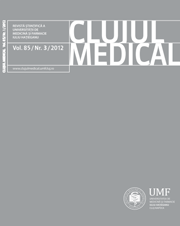Atonic Wound Care – a Challenge for the Health Care Personnel Education in Romania
Keywords:
wound, debridement method, educationAbstract
Objectives. To identify current practices related to wound debridement in Romania, we conducted a study in order to obtain information on existing knowledge and preferences of the medical staff for using debridement methods. This paper summarizes, presents and discusses only the aspects of Romanian medical professionals’ knowledge in wound care.
Materials and Method. Data were collected using a structured questionnaire divided into four sections: respondents’ demographic characteristics, level of knowledge regarding wound management, debridement methods currently used in clinical practice, perception of the level of education needed to perform various types of debridement. The questionnaire was applied during the National Congress of Surgery, 3-6 May 2010, Cluj-Napoca. Responses were coded and organized in a database used for statistical evaluation. Data were processed with SPSS Statistics software (descriptive statistics, ANOVA test, Tukey test, Pearson correlation coefficient).
Results. We obtained 104 complete data sets. Statistical analysis shows that nurses spent more time on wound care than physicians (p<0.017). There were statistically significant differences (p<0.005) between the concepts contained in the courses followed by the medical professional categories studied. Significant correlations (p<0.01) were found between the type of debridement most used in practice and staff’s perceptions about the method’s effectiveness and safety.
Conclusions. In Romania, education of all medical staff in wound care requires a standard at a level with the area of clinical practice as well as scientific and technical progress.
Downloads
Published
How to Cite
Issue
Section
License
The authors are required to transfer the copyright of the published paper to the journal. This is done by agreeing to sign the Copyright Assignment Form. Whenever the case, authors are also required to send permissions to reproduce material (such as illustrations) from the copyright holder.

The papers published in the journal are licensed under a Creative Commons Attribution-NonCommercial-NoDerivatives 4.0 International License.

